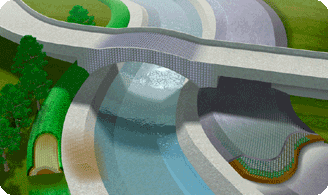Ground stabilization is the most critical chapter of Geotechnical Engineering along with a load support system. That’s why more than enough methods are developed for stabilization using a wide array of materials. From cement, bitumen, geotextile, to lime, here we will discuss all the plausible ways for ground stabilization to improve the soil properties.
Methods for Ground Stabilization:
1: Stabilization with Cement:
When soil is stabilized with cement, it becomes soil cement. A chemical reaction takes place when cement is mixed with siliceous soil during hydration that results in cementing action. To form soil cement, several factors related to soil are taken into accounts, such as soil content, conditions of mixing, curing, and admixtures, and compaction factor.
The amount of cement needed for different types of soil is given below:
- Gravels- 5 to 10%
- Sand- 7 to 12%
- Silts- 12 to 15%
- Clays- 12 to 20%
The quantity of cement for 25 to 30 kg per centimeter square should be sufficient for ground stabilization in a tropical climate. Materials like calcium chloride, sodium carbonate, fly ash, or sodium sulfate can also be added during the cement stabilization of soil.
2: Stabilization using Lime:
Lime can be used alone or can be combined with cement, fly ash, or bitumen to stabilization. Slaked lime is considered effective in treating clayed soils. In general, lime is mainly used for road bases and subgrade stabilization. When you add lime in the soil, a pozzolanic action takes place, which leads to changes in the nature of the adsorbed layer.
- 2 to 8% of lime is required for coarse-grained soil.
- 5 to 8% lime required for plastic soil.
- Mixed with fly ash, 8 to 20% lime of the weight of the soil might also be required for other soil types.
By adding lime, there will be an increase in optimum water content, and maximum compacted density will be decreased. This increases the strength and durability of the soil.
3: Stabilization with Bitumen:
Bituminous materials such as asphalt and tars are also commonly used for ground stabilization. These are typically used for pavement construction. When the bituminous material is added in the soil, it gives cohesion and reduced water absorption feature to the soil. Various types of bitumen stabilization that can be done are given below:
- Sand Bitumen Stabilization
- Soil Bitumen Stabilization
- Waterproof mechanical stabilization
- Oiled Earth
4: Stabilization with Geotextile:
The geotextile solution for ground stabilization consists of porous fabrics that are made of synthetic materials such as polyester, polyethylene, PVC, and nylons. As geotextile offer high strength to the soil, there is a variety of materials available. When the geotextile material is adequately embedded in the soil, it contributes to the stability making the soil suitable for the construction of unpaved roads.
5: Chemical Stabilization of Soil:
For ground stabilization using chemicals, calcium chloride is popularly used. Being a hygroscopic and deliquescent water retentive additive material, it mechanically stabilizes soil base and surface. It further reduces the vapor pressure and rate of evaporation while increasing the surface tension. Calcium chloride facilitates compaction and acts as a soil flocculent. To use the chemical for stabilization, make sure that the relative humidity in the atmosphere must be above 30%.
Sodium chloride and Sodium silicate can also be used for stabilization. Other chemicals that will give a similar effect include polymers, chrome lignin, alkyl chlorosilanes, amines, and quaternary ammonium salts, phosphoric acid, etc.
6: Stabilization by Grouting:
Grouting is an electrical stabilization technique for clayey soils. The process is known as electro-osmosis. As this method is expensive for ground stabilization, it is mostly used for drainage of cohesive soils. With this method, the stabilizers are injected in the soil that affects the permeability.
There are various grouting techniques available for stabilization, such as:
- Clay grouting
- Chemical grouting
- Chrome lignin grouting
- Polymer grouting
- Bituminous grouting
All these methods are used in general for physical, mechanical, or chemical change in the natural properties of the soil so that they will meet engineering requirements. Mostly the solutions offered are meant to be non-destructive and useful to improve the load-bearing capacity of the soil. That’s where; C6XTY introduces the FlexBlox system as a solution for such problems.
Identify the Problem & Solution for Load Support:
The load support systems problems arise when the surface soil is unstable, soft subgrade of soil is encountered, or there is an aesthetic/environmental consideration. All these constraints have a massive impact on the soil structure that needs to be appropriately addressed.
Each connection point on the road or structure is designed so that it can support and transfer a specific type of load or tolerate a loading condition. No matter what material you are using, the connection must have a certain amount of rigidity. Only the stiff connections will be able to maintain the right angle between the connected members.
Hence, the load support system is designed to offer a highly effective and economical solution for roads, parking spaces, and yard surface problems. It covers issues such as subgrade material failure or instability of base material. The 3-D cellular structure designed by C6XTY serves as an explicit infill material for vertical and lateral movement.
When this load support system is placed under the pavement, it will significantly improve the life of the roadway and reduce the overall installation cost as well.
FlexBlox provides a system whose internal architecture is designed to provide superior load distribution. The multi-axial tensile web ensures that shear failure can be prevented. It also maintains permeability by limiting the lateral movement of the aggregate infill. C6XTY is offering you a remarkable solution for ground stabilization and load support systems that distribute the loads laterally by limiting the contact pressure of unstable subgrade.
Talk to C6XTY to learn more about their FlexBlox solutions.

